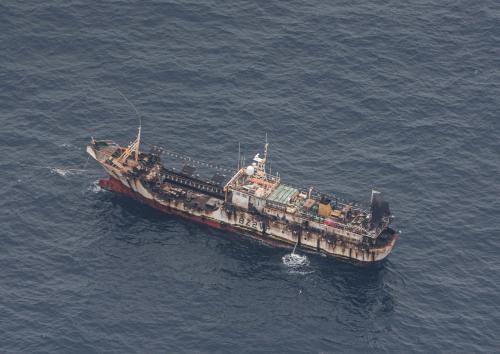Coinciding closely with the release of the National Security Strategy (NSS) was the release of the United States Coast Guard Strategy (CGS). This was the first high-level service strategy document released by the Coast Guard under new Commandant Admiral Linda Fagan. It built upon the themes of “tomorrow looks different, so will we” and “readiness, resilience, and capability” that she laid out when she took over as the Coast Guard’s senior officer this summer. The CGS lays out a robust strategic framework based on three cornerstones: transforming the Coast Guard’s workforce, sharpening its competitive edge, and advancing its mission excellence.
The NSS and CGS depict no shortage of global challenges, including climate change, energy security, transnational criminal organizations, challenges to the rules-based order, natural disasters, and geopolitical changes. While many of these challenges are not new, they are dynamic and evolving. The Coast Guard has long been operating in the high latitudes — the Arctic and Antarctic — and is one of the few government entities which does so consistently. As the climate changes and the Arctic becomes more accessible, there will be new challenges related to tourism, natural resource extraction, new shipping lanes, and an increased military presence from other nations looking for influence in the region. Recent incidents show that the maritime commons are becoming more contested: efforts by transnational criminal organizations such as drug cartels to exploit the vastness of the oceans for illicit means, and actions taken by foreign-flagged vessels fishing far from where they launched, that were dangerous and not in compliance with international norms. The Coast Guard must remain committed to providing the exceptional service the nation expects in legacy missions such as search and rescue, law enforcement, disaster response, waterways management, and industry engagement. Yet, it is also adapting to meet new and in some cases yet unknown challenges in non-escalatory ways.
The NSS dedicates an entire section to “investing in our strength.” Due to its multi-mission nature conducting humanitarian response, environmental stewardship, law enforcement, and regulatory work, its membership in the intelligence community, and its status as a branch of the armed forces, the CGS lays out a strong case for the Coast Guard’s unique capability to build and sustain partnerships at multiple levels internationally and domestically. With the NSS’s heavy focus on partnerships and cooperation and the Indo-Pacific Strategy specifically mentioning the Coast Guard by name, there is no doubt the Coast Guard will be expected to do more in this arena. This will be especially true in Oceania where the Coast Guard’s unique capabilities in search and rescue, maritime law enforcement, and small vessel operations make it a natural partner for many small island nations in the region. The Coast Guard has capitalized on the recent arrival of new fast response cutters by deploying the boats throughout the region to bolster foreign partner relations and combat illegal, unregulated, and unreported fishing. Funding from Congress for additional cutters, training teams, local liaisons, and mission support needs is required to create a sustained presence in the region and realize the outsized impact the Coast Guard can have on the NSS’s stated goal of “promoting a free and open Indo-Pacific.”
Mirroring the NSS’s focus on “investing in our people” and “modernizing and strengthening our military,” Fagan states early in the CGS, “Delivering improvements for our Coast Guard workforce is my top priority.” Revolutionizing talent management and recruiting, modernizing learning, and improving healthcare and family services are the CGS’s focus for transforming its workforce. The Coast Guard must seize the opportunity to revamp its training systems with a move toward more virtual in-person and virtual self-paced training. Doing so will both help deal with austere budget realities and deliver the training necessary to operate and maintain increasingly complex systems.
While training system improvements will pay long-term dividends, this is only true if there is a full workforce to train. Recruiting is an especially urgent issue as the Coast Guard is suffering from some of the same challenges as the Department of Defense (DOD) in fielding the all-volunteer force. Targeted bonuses and likely increases in 2023 to basic pay and housing allowances will help with recruiting and retention, however these are unlikely to solve the Coast Guard’s already existing personnel shortages. With an estimated 75% of the target population not eligible for military service, the Coast Guard is increasingly competing with the DOD and the civilian sector for the same personnel. The Coast Guard must act aggressively to ensure recruiting efforts can meet mission requirements. While the service has already more closely aligned its medical criteria for accession with the DOD, it should look for innovative ways to help more people who want to serve in the Coast Guard able to realize the opportunity. One area that should be explored immediately is something akin to the Army’s Future Soldier Prep Course, designed to help potential recruits with obesity or trouble on the Armed Forces Qualification Test meet the requirements to attend boot camp.
Harnessing technology to “increase security, prosperity, and values of the American people” comes up several times in the NSS. On this front, the Coast Guard has significant work to do but also tremendous opportunities. The CGS emphasizes investing in critical technology and critical infrastructure, a future-focused integrated approach, expanding a culture of innovation, and leveraging data to sharpen the service’s competitive edge. Although partnering with the DOD to operationalize new technology can be advantageous, the Coast Guard must find its own innovative ways to employ autonomy in the air, on the surface, and below the surface. The service can’t be paralyzed by the rapid increase in autonomous capabilities. It should move quickly to finalize policy and begin fielding more autonomous capabilities, even if only in small field trials. The longer it delays, the further behind it will fall, and the less it will be able to realize technological advantages when faced with challenges.
On the cyber front, it is now clear there is a real and persistent threat in the cyber domain that is here to stay. As the NSS highlights, even in future conflicts not contested in the maritime domain or even near American shores, there is an avenue by which our adversaries can strike deep within our borders. The waterways, ports, navigation aids, vessels, vehicles, and users collectively known as the Maritime Transportation System, account for 90% of global trade travel, $5.4 trillion of annual commerce in the United States, and 31 million American jobs, per the American Association of Port Authorities. It is vulnerable to cyberattacks in ways not previously seen, and must be defended.
Dealing with this threat is one of the greatest challenges to the Coast Guard’s “Always Ready” posture. Previously this meant being ready and responding in the air, on shore, and at sea. It now must include virtually, which is a big leap for the Coast Guard and industry. Given current cyber threats from Russia and China, the Coast Guard should continue investing in cyber security for its own internal networks and accelerate working with industry to strengthen cyber resilience in the larger Maritime Transportation System.
The Coast Guard must maintain its existing strong network of domestic relationships at the federal, state, local, and tribal levels, which are paramount to national security. It must maintain legacy capabilities while developing new ways of operating and uses of technology that meet emerging challenges. And it must safely coexist with adversarial entities who may not share the same level of adherence to international norms. Underpinning all of this are multiple long-term acquisition programs to replace its aging surface fleet, sustain aviation capabilities, improve C5I systems (command, control, communications, cyber, and intelligence), and replace or repair shore infrastructure, including aging buildings, hangars, and piers. To successfully execute all of this, the Coast Guard will need continued support from Congress in an austere budget environment, and it will need to manage these acquisitions — which are some of the largest in the service’s history — effectively.
The CGS lays out an aggressive path to ensure the service can meet the challenges associated with rapid technology, workforce, and geopolitical change. However, it will also be necessary to keep the Coast Guard postured to support the NSS and at the forefront of saving lives, protecting the waterways, defending the country, and remaining “Always Ready.”
The views expressed herein are solely those of the author and do not necessarily represent the views of the U.S. government or the Brookings Institution.








Commentary
As the National Security Strategy is released, can the Coast Guard stay “Always Ready”?
December 9, 2022